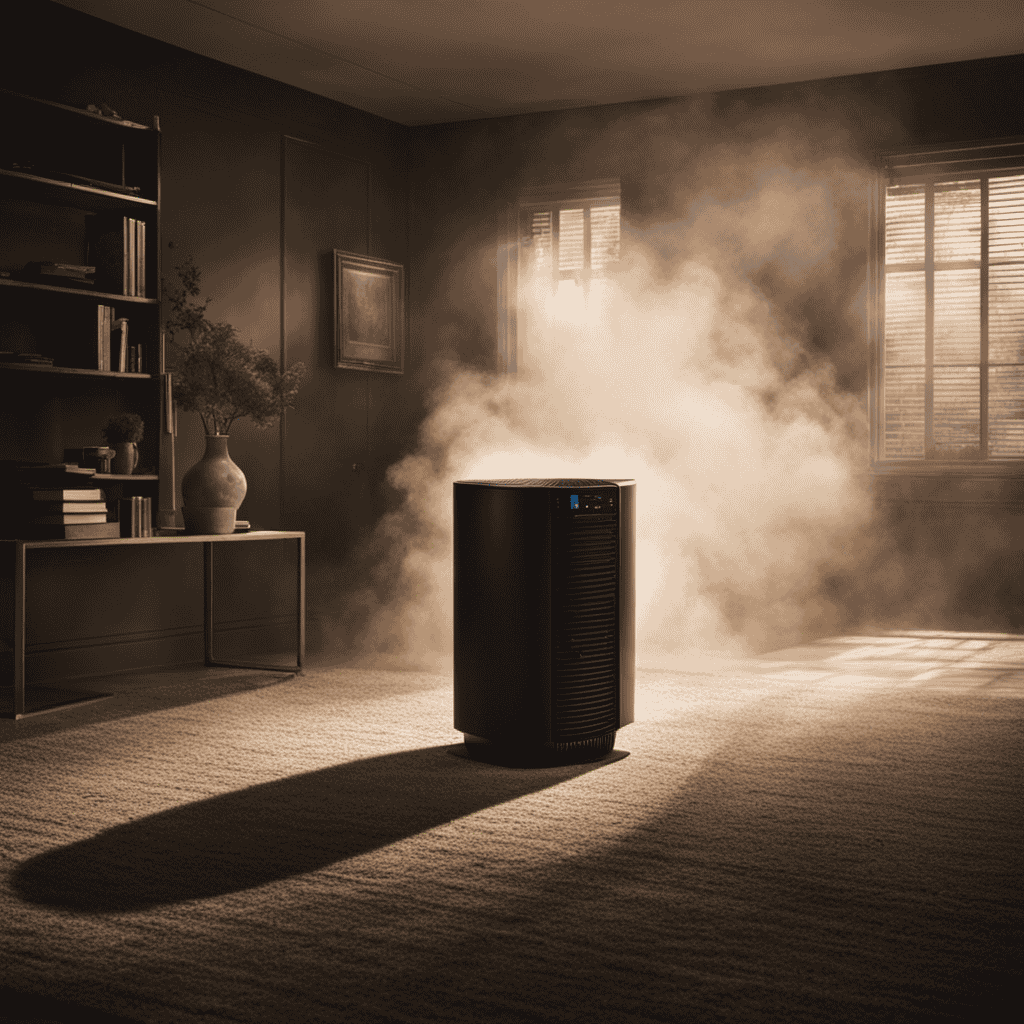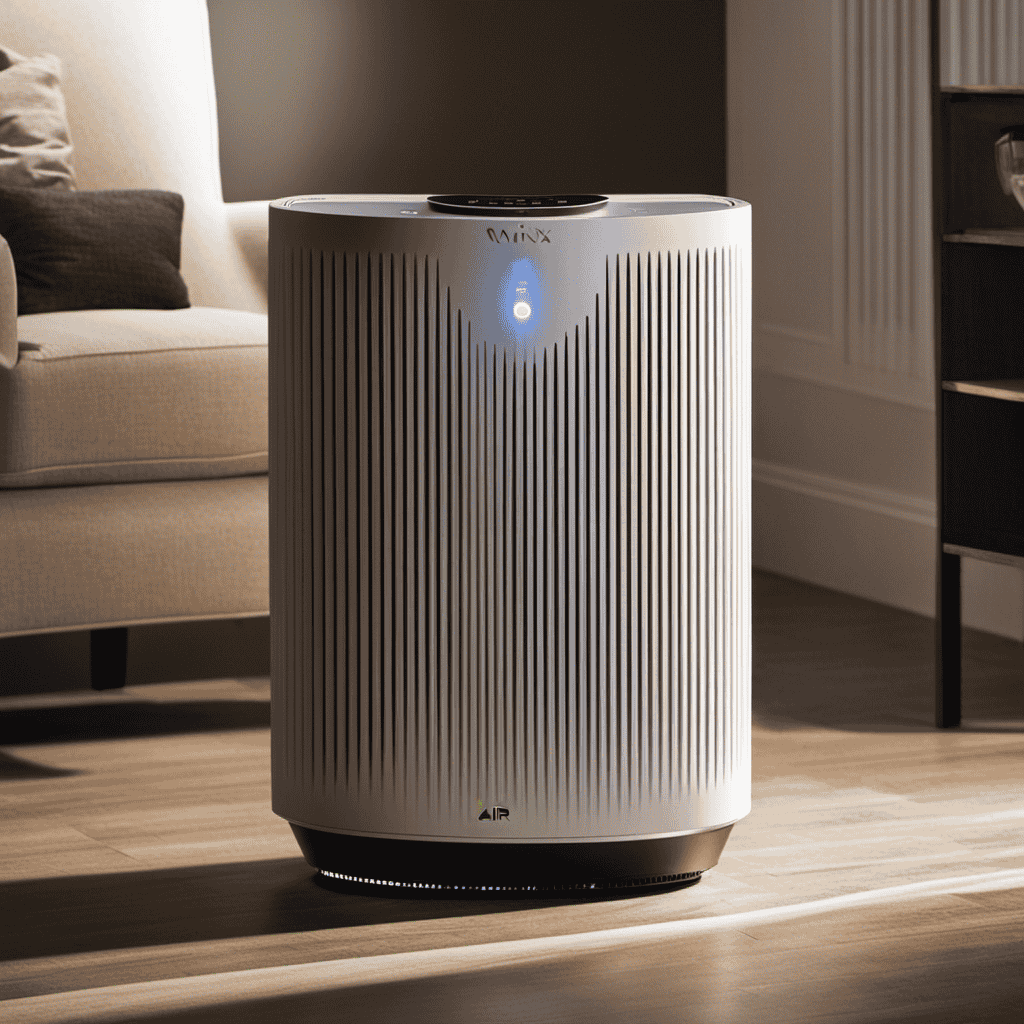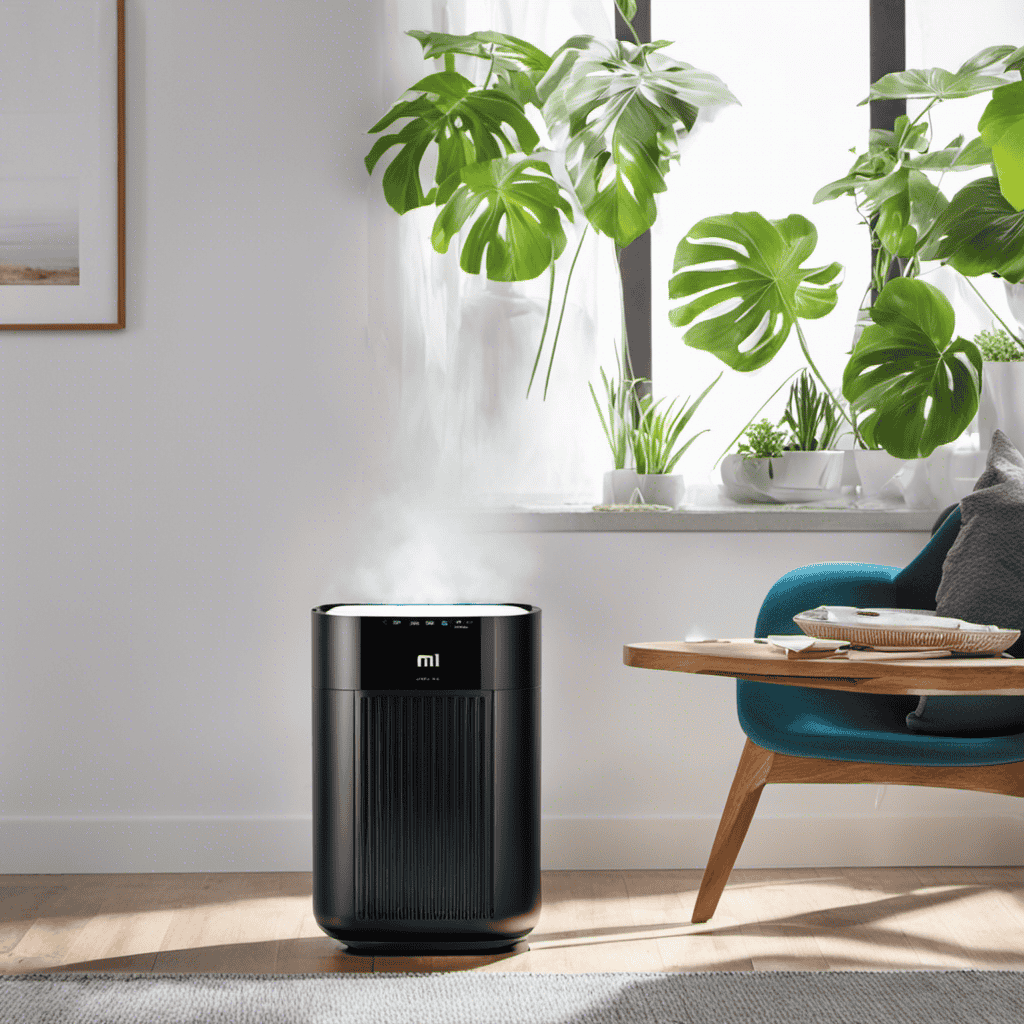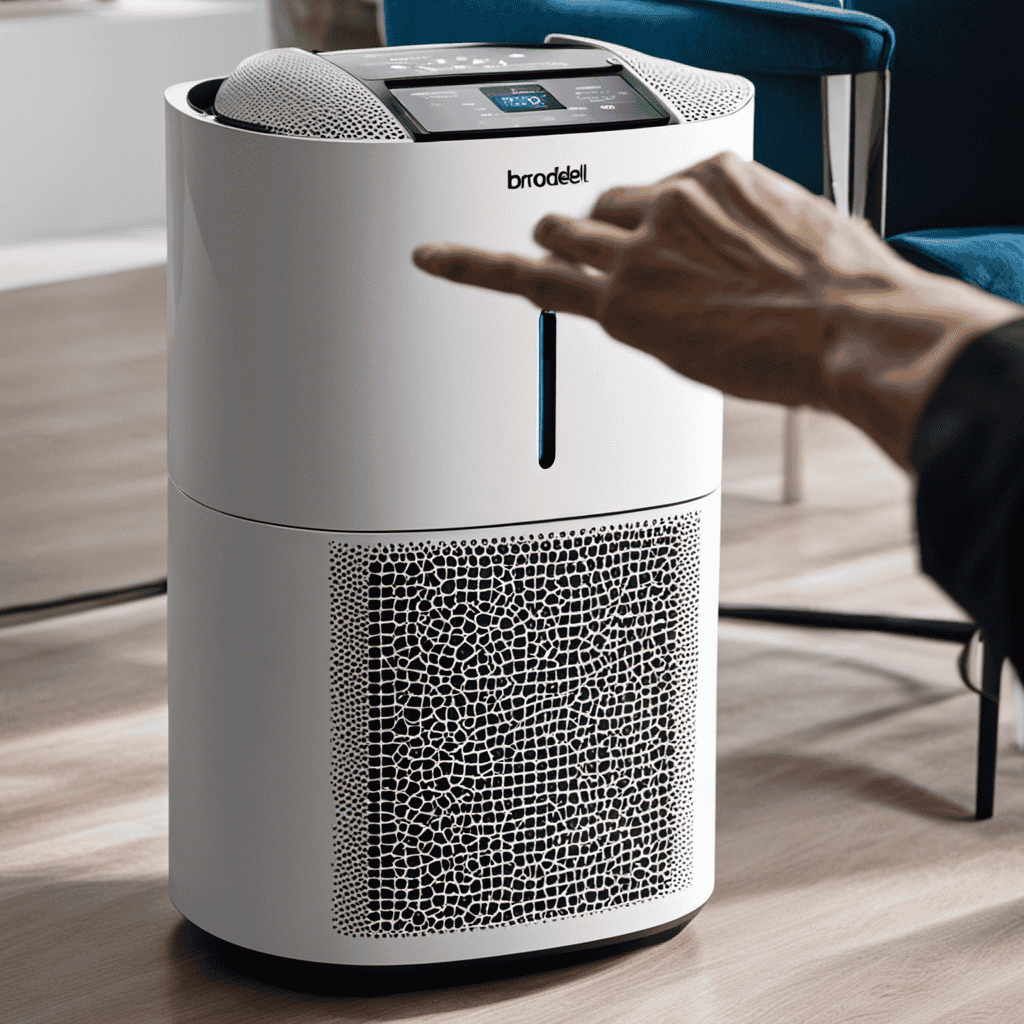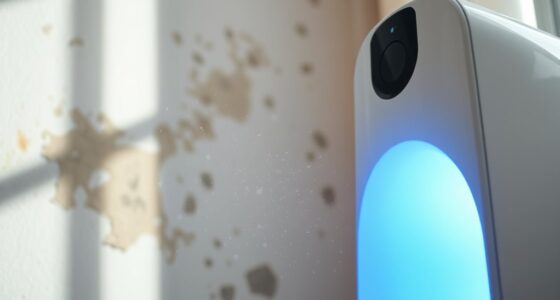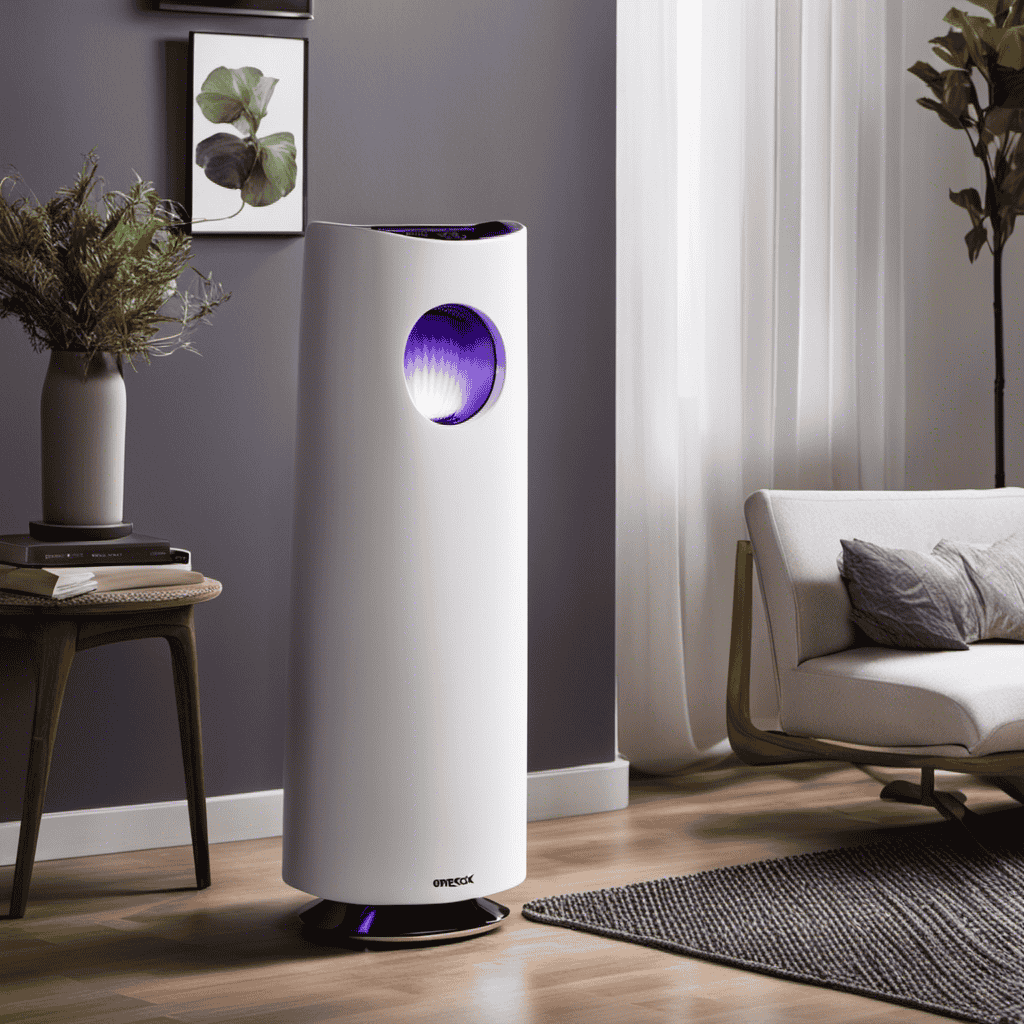As the owner of an air purifier, I depend on it to maintain clean and fresh air in my home. Unfortunately, recently, I have observed that it is not operating as efficiently as before. It is quite frustrating, to say the least.
But fear not, for in this article, I will delve into the possible reasons why your air purifier may not be working and provide you with troubleshooting tips to get it back on track.
Let’s dive in and uncover the mysteries behind your malfunctioning air purifier.
Key Takeaways
- Ensure the power cord is securely plugged in and the power switch is in the ‘on’ position
- Follow a regular filter replacement schedule and check the indicator light for filter replacement or cleaning
- Test the fan functionality by listening for spinning or humming sounds and checking for air movement near the air vents
- Regularly clean the sensor to remove dust or debris and ensure proper calibration for accurate air quality measurement
Troubleshooting the Power Supply
You should check if the power cord is securely plugged in before proceeding with troubleshooting the power supply of your air purifier. A loose or disconnected power cord is one of the most common air purifier problems that can easily be fixed.
Start by unplugging the power cord and then plugging it back in, ensuring a snug fit. If the power cord is securely connected and your air purifier still doesn’t turn on, try plugging it into a different outlet to rule out any issues with the power source. Additionally, make sure the power switch on the air purifier is in the ‘on’ position.
If none of these steps resolve the issue, you may need to consult the user manual or contact customer support for further assistance.
Now, let’s move on to checking the air filter.
Checking the Air Filter
When it comes to checking the air filter in your air purifier, there are a few key points to keep in mind.
Firstly, a clogged air filter can significantly reduce the efficiency of your purifier and lead to poor air quality.
Secondly, proper filter installation is crucial to ensure that air is effectively filtered and contaminants are trapped.
Lastly, following a regular filter replacement schedule is essential to maintain optimal performance and prolong the lifespan of your air purifier.
Clogged Air Filter
The air purifier’s not working because the air filter’s clogged. Proper maintenance of an air purifier is essential for its optimal performance. If you are experiencing issues with your air purifier, follow these troubleshooting steps to determine if the air filter is the culprit:
- Check the indicator light: Many air purifiers have an indicator light that alerts you when the air filter needs to be replaced or cleaned.
- Inspect the air filter: Remove the air filter and examine it for any visible dirt, debris, or discoloration. A clogged filter will restrict airflow and reduce its efficiency.
- Clean or replace the air filter: Depending on the type of air filter, you may be able to clean it with water or a vacuum. If the filter is too dirty or damaged, replace it with a new one.
Proper Filter Installation
Properly installing the filter is crucial for the effective functioning of your air purifier. To ensure optimal performance, it is essential to follow the correct steps during the filter installation process.
First, make sure to turn off the air purifier and unplug it from the power source. Locate the filter compartment, usually located at the back or side of the unit. Open the compartment and remove the old filter carefully. Take note of the filter type and size, as you will need this information when purchasing a replacement.
Insert the new filter into the compartment, making sure it fits snugly and securely. Close the compartment and plug in the air purifier. Regular filter maintenance, such as cleaning or replacing the filter as recommended by the manufacturer, is important to ensure the proper functioning of your air purifier.
If you encounter any issues, consult the troubleshooting guide provided by the manufacturer for further assistance.
Filter Replacement Schedule?
It’s important to follow the recommended filter replacement schedule to ensure optimal air purifier performance. Neglecting to replace the filters regularly can lead to a variety of common air purifier problems.
Here’s what you need to know:
-
Filter replacement frequency: Depending on the specific model and usage, filters generally need to be replaced every 3-6 months. However, it’s essential to consult the manufacturer’s guidelines for your particular air purifier.
-
Reduced effectiveness: Over time, filters become saturated with pollutants, reducing their ability to capture and remove harmful particles from the air. This can result in poor indoor air quality and increased allergy symptoms.
-
Clogged filters: When filters are not replaced on time, they can become clogged with dirt and debris. This puts a strain on the air purifier’s motor and can cause it to overheat or malfunction.
Evaluating the Fan Functionality
You can check if the fan on your air purifier is working by listening for any spinning or humming sounds.
The fan is a critical component of the air purifier as it helps circulate air and improve indoor air quality.
To evaluate noise levels and test the air purifier’s performance, start by turning on the device and placing your ear close to the unit.
Listen carefully for any abnormal or excessive noise coming from the fan. A functioning fan should produce a smooth and consistent spinning sound without any rattling or grinding noises.
Additionally, observe if the fan is effectively moving air by feeling for a steady flow near the air vents.
If you notice any issues with the fan, such as unusual noise or lack of air movement, it might be necessary to contact a professional for further inspection and repair.
Investigating the Sensor System
To investigate the sensor system, try placing your hand in front of the air purifier to see if the device detects your presence and adjusts its settings accordingly. Sensor calibration is crucial for accurate air quality measurement.
Here are some key points to consider:
- Check if the sensor is properly calibrated by referring to the user manual or contacting customer support.
- Ensure that there are no obstructions in front of the sensor, such as curtains or furniture, as this can affect its performance.
- Clean the sensor regularly to remove any dust or debris that may interfere with its readings.
Analyzing the Control Panel
Check if there are any error codes or warning indicators displayed on the control panel, as this can provide valuable information about the current status of the air purifier.
The control panel serves as the central hub for operating and monitoring the air purifier. It allows you to adjust settings, such as fan speed, timer, and mode.
If there are any sensor malfunctions, the control panel will usually indicate this through an error code or warning indicator. Pay attention to these codes or indicators, as they can help identify the source of the problem.
Additionally, familiarize yourself with the control panel settings and their functions, as incorrect settings can also lead to issues. Understanding the control panel is crucial for troubleshooting and addressing potential maintenance issues.
Addressing Potential Maintenance Issues
Take note of any regular maintenance tasks that need to be performed on the air purifier to ensure its optimal performance. Regular maintenance is essential to keep your air purifier running smoothly and efficiently.
Here are some important maintenance tasks to consider:
- Clean or replace the filters regularly to remove dust, allergens, and other particles from the air.
- Check the fan and motor for any signs of dust or debris buildup and clean them if necessary.
- Inspect the air vents and ensure they are not blocked or obstructed.
If you are experiencing noise issues with your air purifier, try troubleshooting the problem by checking for loose components or excessive dirt. If the noise persists, it may indicate a more serious problem that requires professional assistance.
When addressing warranty concerns, carefully review the terms and conditions of your air purifier’s warranty. Contact the manufacturer or retailer if you believe your unit is experiencing a warranty-covered issue. They will be able to guide you through the warranty claim process and provide the necessary support.
Examining the Air Quality Sensor
I’ve noticed that my air purifier is not accurately detecting the air quality in my home. This led me to examine the air quality sensor.
One possible issue could be a faulty sensor. It may require replacement or repair. Regular maintenance and cleaning of the sensor is crucial to ensure its proper functioning and accuracy.
Another potential problem could be sensor calibration issues. These can result in inaccurate readings and may require recalibration for optimal performance.
Faulty Air Quality Sensor
The air purifier’s not working properly due to a faulty air quality sensor. This sensor is responsible for detecting the level of pollutants in the air and triggering the purification process. However, when the sensor is faulty, it cannot accurately calibrate the air quality, resulting in a decrease in the purification efficiency.
There are a few possible reasons for the sensor’s malfunctioning. Firstly, it could be due to a manufacturing defect or damage during transportation. Secondly, the sensor might have become dirty or clogged with dust particles, hindering its ability to accurately measure air quality. Lastly, the sensor might require calibration to ensure its accuracy.
To address the issue, you can try cleaning the sensor using a soft brush or compressed air. If this doesn’t work, contacting the manufacturer for assistance or considering replacing the faulty sensor altogether might be necessary.
Ensuring the proper functionality of the air quality sensor is crucial for maintaining the purification efficiency of your air purifier.
Maintenance and Cleaning
To properly maintain and clean your air purifier, you should regularly remove and clean the filter to ensure its efficiency in removing pollutants from the air. This is one of the most important air purifier maintenance tips.
Start by turning off the unit and unplugging it from the power source. Locate the filter compartment and carefully remove the filter. Gently vacuum or brush off any visible dust or debris from the filter.
If the filter is washable, rinse it under running water and let it air dry completely before reinstalling. For non-washable filters, replace them according to the manufacturer’s instructions.
Regularly cleaning or replacing the filter will prevent common air purifier problems such as reduced performance and the spread of airborne contaminants.
Sensor Calibration Issues
If you’re experiencing sensor calibration issues, try resetting the air purifier to see if that resolves the problem. Sensor calibration troubleshooting is an essential part of air purifier maintenance.
Here are some tips to help you troubleshoot and maintain your air purifier:
-
Check the sensor placement: Ensure that the sensor is positioned correctly and not obstructed by any objects. Incorrect placement can affect the accuracy of the sensor readings.
-
Clean the sensor: Dust and debris can accumulate on the sensor over time, leading to calibration issues. Use a soft cloth or brush to gently clean the sensor surface.
-
Update firmware: Some air purifiers have firmware updates available. Check the manufacturer’s website for any available updates and follow the instructions to install them.
Understanding the Purification Technology
Have you tried researching the purification technology used in your air purifier? Understanding the purification technology is crucial for proper air purifier maintenance and troubleshooting.
Over the years, there have been significant advancements in purifier technology, resulting in more efficient and effective air purification. One of the common technologies used is High-Efficiency Particulate Air (HEPA) filters. These filters are designed to capture even the smallest particles, including allergens, dust, and pet dander.
Additionally, some air purifiers use activated carbon filters to remove odors and volatile organic compounds (VOCs) from the air. Understanding the technology behind your air purifier can help identify potential issues and ensure proper maintenance.
However, if you’re still experiencing problems, it may be time to seek professional assistance to diagnose and resolve the issue accurately.
Seeking Professional Assistance
When seeking professional assistance for your air purifier, it’s important to find a qualified technician who specializes in air purification systems. Seeking professional advice can help you troubleshoot and resolve any issues you may be experiencing with your air purifier.
Here are some troubleshooting techniques that a professional technician can provide:
- Perform a thorough inspection of the air purifier to identify any potential problems.
- Use specialized tools and equipment to test the functionality of the air purifier’s components.
- Provide expert advice on maintenance and cleaning routines to ensure optimal performance.
By consulting a professional, you can gain valuable insights into the specific issues affecting your air purifier and receive accurate guidance on how to address them.
This will help you restore your air purifier’s functionality and ensure that it continues to provide clean and healthy air for you and your family.
What Could Be Causing My Therapure Air Purifier to Stop Working?
If your Therapure air purifier suddenly stops working, it could be due to a dirty filter. Another common issue could be a malfunctioning sensor or electrical problem. Try cleaning or replacing the filter, and if that doesn’t work, consider seeking professional help for repairing or replacing the unit using therapure air purifier.
Frequently Asked Questions
How Do I Know if My Air Purifier Is Working Properly?
I can determine if my air purifier is working properly by checking for indicators like a functioning power button, clean filters, and proper airflow. Regular maintenance and troubleshooting guide can help identify any problems.
What Should I Do if My Air Purifier Is Not Turning On?
If my air purifier is not turning on, I would first check the power source and ensure it’s properly connected. If that doesn’t solve the issue, I would refer to the troubleshooting tips and common reasons for malfunctioning.
How Often Should I Replace the Air Filter in My Purifier?
When it comes to replacing the air filter in my purifier, it’s essential to clean it regularly to ensure optimal performance. Additionally, choosing the right air filter that suits my purifier’s specifications is crucial for its efficiency.
Can a Malfunctioning Fan Affect the Overall Performance of the Air Purifier?
Yes, a malfunctioning fan can greatly affect the overall performance of an air purifier. It can lead to reduced airflow, which decreases the efficiency of the purifier in removing airborne particles. Troubleshooting common fan issues is crucial for optimal performance.
What Are Some Common Signs of a Faulty Sensor System in an Air Purifier?
When the sensor system in an air purifier is faulty, it can lead to poor indoor air quality. Common causes include dust buildup or sensor damage. Troubleshooting tips include cleaning the sensor or contacting customer support.
Conclusion
In conclusion, troubleshooting an air purifier involves thorough examination of its power supply, air filter, fan functionality, sensor system, control panel, and potential maintenance issues. It is also important to understand the air quality sensor and purification technology.
However, if all attempts fail, seeking professional assistance is advisable. Interestingly, according to a study conducted by the Environmental Protection Agency (EPA), indoor air can be up to five times more polluted than outdoor air, highlighting the crucial role of air purifiers in ensuring clean and healthy indoor environments.
